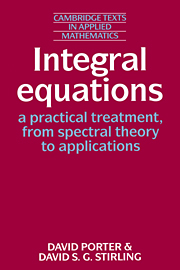Book contents
- Frontmatter
- Contents
- Preface
- 1 Classification and examples of integral equations
- 2 Second order ordinary differential equations and integral equations
- 3 Integral equations of the second kind
- 4 Compact operators
- 5 The spectrum of a compact self-adjoint operator
- 6 Positive operators
- 7 Approximation methods for eigenvalues and eigenvectors of self-adjoint operators
- 8 Approximation methods for inhomogeneous integral equations
- 9 Some singular integral equations
- Appendix A Functional analysis
- Appendix B Measure theory and integration
- Appendix C Miscellaneous results
- Notation Index
- Index
7 - Approximation methods for eigenvalues and eigenvectors of self-adjoint operators
Published online by Cambridge University Press: 05 June 2012
- Frontmatter
- Contents
- Preface
- 1 Classification and examples of integral equations
- 2 Second order ordinary differential equations and integral equations
- 3 Integral equations of the second kind
- 4 Compact operators
- 5 The spectrum of a compact self-adjoint operator
- 6 Positive operators
- 7 Approximation methods for eigenvalues and eigenvectors of self-adjoint operators
- 8 Approximation methods for inhomogeneous integral equations
- 9 Some singular integral equations
- Appendix A Functional analysis
- Appendix B Measure theory and integration
- Appendix C Miscellaneous results
- Notation Index
- Index
Summary
Introduction
We have seen that the solution of an equation of the form φ = f + λKφ can, in some circumstances, be expressed as the sum of a series involving all the eigenvalues µn and eigenvectors φn of the operator K. From a theoretical point of view this solution is of undoubted importance, but its practical use is limited by the fact that there are comparatively few operators for which the sequences (µn) and (φn) are known. If these sequences are not known exactly, there remains the prospect of estimating the first N eigenvalues and eigenvectors of K and approximating the solution of φ = f + λKφ by truncating the associated series.
We shall in fact consider approximation methods for the equation φ = f + λKφ in the following chapter. There it will emerge that a knowledge of the dominant eigenvalues of K (that is, its largest positive eigenvalue and its negative eigenvalue of largest magnitude) is of particular value in implementing several of these methods.
In an integral equation arising from a practical problem, λ itself is a quantity of some significance. A simple illustration of this fact was given in Example 1.3, where λ = 1/µ is proportional to the square of the frequency of vibration of a thin rod. The eigenvalues in this case give the natural frequencies of oscillation of the rod, that is, the frequencies at which resonance will occur in certain forced motions of the rod.
- Type
- Chapter
- Information
- Publisher: Cambridge University PressPrint publication year: 1990



